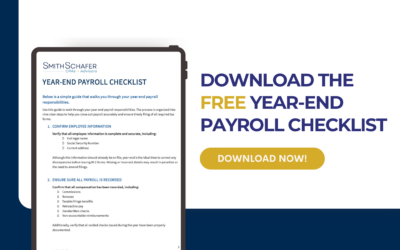Minnesota’s Paid Family & Medical Leave (PFML) program is bringing significant changes for employers and employees alike. At Smith Schafer, we are committed to helping Minnesota businesses stay informed and prepared.
This article is part of our ongoing series on Minnesota’s new Paid Family & Medical Leave (PFML) program. In previous posts, we’ve explained the employer exemption process, outlined account setup requirements and key deadlines, and provided an overview of Minnesota’s new Paid Leave law. In this installment, we focus on the tax implications for employers and employees.
Here we discuss how taxes are going to work for the upcoming MN Paid Family and Medical Leave Act. As Minnesota prepares for its Paid Leave program, understanding the tax implications is crucial. Here’s a breakdown of key points to help navigate state and federal tax considerations under Minnesota’s Paid Leave system.
Will Paid Leave Benefits Be Taxed?
Yes, Minnesota Paid Leave benefits are subject to taxes. The IRS issued guidance on January 15, 2025, in Revenue Ruling 2025-4, outlining how paid leave premiums and benefits will be taxed. Minnesota will follow these federal rules when determining taxability.
How Premiums Affect W-2 Reporting
• Minimum contributions only: No change to the employee’s W-2. The employee’s share is withheld but remains taxable for FICA, federal, and state purposes.
• Employer pays more than required: The extra amount is added as taxable wages on the W-2 and subject to payroll taxes.
Employers should ensure payroll systems are set up correctly. Smith Schafer’s Outsourced Accounting team can help with reporting and compliance.
Are Premiums Tax-Deductible?
- For Employees: If an employer covers more than the minimum share of the premium, that contribution is treated as additional compensation and is included in the employee’s taxable wages. Employees may deduct this additional premium contribution as a state income tax deduction if they itemize deductions on their federal return, within certain limits.
- For Employers: Employers can deduct both the required and any additional premium contributions. If the employer pays more than the minimum required share, that amount is deductible as a business expense and must be included as wages on the employee’s W-2.
For strategic planning, employers may want to review contributions with their Tax Advisor.
How Are Paid Leave Benefits Taxed?
- Family Leave: Family leave benefits are not considered wages and are not subject to employment taxes. They are reported to the IRS annually, and recipients will receive a 1099 form for their benefits. Employees can also opt to have state and federal taxes withheld.
- Medical Leave: Medical leave benefits are taxed differently. Half of the benefits (the portion covered by the employer) are treated as taxable wages. The other half (employee-paid portion) is excluded from taxable income. The employer must treat the employer-funded portion as wages for tax purposes and report it as third-party sick pay on the employee’s W-2, which is subject to federal tax withholding, Social Security, and Medicare taxes.
Employers should communicate these rules to staff to avoid confusion at tax time.
Withholding Taxes from Paid Leave Benefits
Employees can choose to have state and federal taxes withheld from their weekly Paid Leave benefits. The rates are set at:
- 5% for state taxes (Minnesota)
- 10% for federal taxes
These rates are determined by Minnesota state law, not the IRS.
Employers should advise employees of these options during onboarding or benefit enrollment.
Employer Responsibilities
Employers must:
• Include taxable medical leave benefits on employee W-2s
• Stay updated with guidance from the state
• Ensure payroll systems handle both premiums and taxable benefits correctly
Many employers find it helpful to partner with advisors for ongoing compliance support, such as Payroll & Accounting Services.
Conclusion
Minnesota’s Paid Leave program introduces a unique set of tax responsibilities for both employers and employees. By understanding how premiums and benefits are taxed, and knowing the options for withholding and deductions, individuals and businesses can better prepare for the coming changes.
Action steps for employers:
- Review payroll processes to ensure proper W-2 reporting of premiums and taxable benefits.
- Decide whether your business will contribute more than the required minimum.
- Communicate how family leave and medical leave benefits will be taxed.
- Consider engaging professional advisors to navigate compliance with confidence.
At Smith Schafer, our team can help you align your payroll, tax reporting, and compliance strategies with Minnesota’s PFML requirements. Whether through Tax Services for navigating reporting and deductions, Outsourced Accounting for payroll support, or Business Consulting for long-term planning, we provide proactive guidance so you can focus on running your business.



